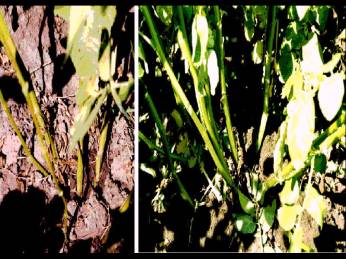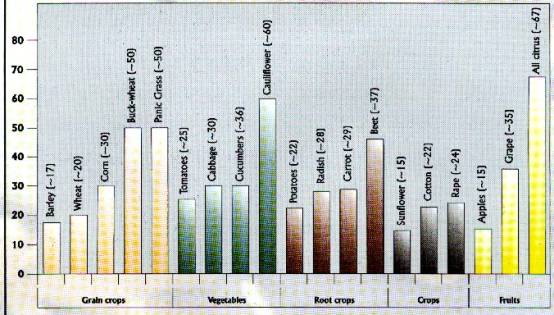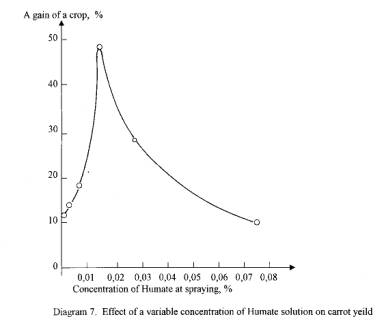

CONTENTS
Please
note, this "book" has been translated into English from its Russian
form. Any small grammatical flaws that occur are simply the result of this
translation.
3. THE EFFECTS OF HUMATES ON CROPS
Information from the previous
chapters answers the question: Why do humates stimulate growth and plant
development? In this chapter I shall try to answer the question: How does this
happen? On one level, experience of Humates usage has a 50-year history and
during that time a huge amount of practical material has been accumulated, but
on another level, the new technology relative to the Irkutsk Humates production,
characterizes a new stage of development. Today we have evidence that this new
technology allows us to not only decrease production costs, but to produce a new
high quality product. Firstly, let us consider the 50-year experience of Humate
usage, based on brown coal and peat, then consider and analyze content and
quality of Irkutsk humates and the results of their usage.
Long-term experience in the use of humates in Russia has shown that their presence is important during all stages of plants’ development but particularly vital in the early stages. That is why the pre-planting treatment of seeds is very important. Even before germination begins, vital forces are awakened, and the immune system is stimulated. A young sprout develops a strong root system, and its endurance increases. Intensification of the root system growth was studied on barley. (L. Ekaterinina, T. Kukharenko, 1971.) As a result of humate treatment, the root length of the plants increased by 2.5 times, and average stem length increased twice, in comparison with the control group. Similar results were obtained in the course of other research and were confirmed by the experience of California citrus growers. (T. Senn & A. Kingman, 1973.)
The treatment of seeds is particularly important for potatoes.
Soaking the potato tubers in the humate solution prior to planting is
practically the only necessary operation in treatment of potatoes, especially
since spraying the vegetating potato plants can lead to growth of the
over-ground parts of the plant at the expense of the tubers’ development.
As you will observe in the following photograph, the treatment of the
tubers prior to planting results in an increase of quantity and vigor of the
shoots.
 |
Fig. 4.
Potatoes after the humate treatment (right) in
comparison with the control group (left).
Naturally, the strengthening of the root system and stems has a positive effect on crops. As plants develop, however, other factors are involved. A strong, developed root system provides plants with the necessary nutrients of a higher quality. Because they are already a part of a certain organic structure, the humates’ chelate complexes with microelements can penetrate into the cell more easily than ordinary ions. The humates increase the penetrability of a cell membrane and, as a result, are conducive to potassium retention in intra-cell fluid, which leads to the increase of cell division. Due to the additional energy supply, a photosynthesis process in the cells proceeds more intensively, leading to an increased amount of chlorophyll. A determining factor in plants’ growth, nitrogen assimilation proceeds more rapidly, and nitrate formation is averted. All together, it leads to an increase in crop capacity. Throughout a long-term history of humate use at the experimental fields, plots, greenhouses, and gardens a lot of data has been collected and published. In mean form, these results are presented in the following diagram. (See Fig. 5.)
Fig. 5. Humates
and the increase in crop capacity in agriculture.

It is important to note that the tests (particularly the ones on
vegetables planted in both open and closed conditions) were carried out on a
wide scale, which ensured accuracy of the results.
For instance, the tests of the oxy-humate preparation were simultaneously
carried out at twenty greenhouse farms in Ukraine and Byelorussia.
The test technologies included soaking of the seeds prior to planting in
water-based humate solution, as well as two-time watering of the vegetating
plants and prophylactic spraying with the humates against disease.
Complex tests of non-ballast humates educed from brown coal of the
Kansk-Achinsk and Dnepropetrovsk coal fields, as well as coal fields near
Moscow, were carried out. Tests on
vegetables, wheat, cotton, and other cultures were carried out in dozens of
hectares of open fields in different regions of the country.
Average humate consumption amounted to 5-10 kg/hectare or 400 liters of
0.005% solution per treatment. When
the first industrial production of ballast humates was established during the
1960s in Ukraine, at the Semenovsky mineral wax works, up to 60 tons per year
were used for agricultural needs.
Thus,
with this extensive research it was established that humates are conducive to a
direct increase in the yield capacity of most agricultural crops.
Important data in humate use in floriculture was
also published. The root and
non-root treatment of arboreal plants (such as Crimean pine), shrubs (three
types of roses), and lianas by the ammonium humate was tested at the Donetsk
botanical gardens. (Science Academy of Ukraine.) The increase in growth of these plants, particularly of roses
and lianas, by the end of vegetation reached 1.3-2 times, compared with the
control group. In 1990-1992,
humates were used for treatment of roses, tulips, hydrangea cuttings, and
socotra, as well as for singling of plants.
In all cases, the flowering accelerated by 5-10 days, while the amount
and size of the buds and their stamina improved.
Other research proved the effectiveness of humate use in ornamental
gardening.
Irkutsk
Humates the mentioned data was published in the
1960s-1980s, and it generalized the experience of using the humates educed
according to the old extracting technology.
These humates were educed from Belo Russian peat and brown coal from
Ukraine, the Kansk-Achinsk coal fields, as well as coal fields near Moscow.
As it was mentioned earlier, these products were not cost-efficient, and
their use in the republics of the USSR was confined to individual, though wide
scale, tests. With the creation of the Irkutsk high-concentrate humates,
substantial changes took place, both quantitative and qualitative.
It was proven by new research and by field tests carried out in the
Irkutsk region during the last three years.
Obviously, the quality of any preparation depends on its composition,
which in turn depends on the initial raw materials. Brown coal and peat contain a 25% to 50% mineral component
that is mostly composed of silicon compounds, as well as calcium and magnesium
salts. After alkali treatment,
these salts, along with the humic acid salts, pass into solution in high
concentrations. They form
water-insoluble compounds with low biological activity.
That is why many technological conditions recommend acid pre-treatment of
raw materials prior to alkali treatment in order to remove most of the mineral
ballast. However, the process was
so complicated by this operation that it was not widely used in practice.
It also made the process much more expensive and presented the problem of
acid waste treatment. The technology developed to produce Irkutsk humates is free
of these drawbacks because it uses naturally oxidized coal of weathering crust,
containing at least 75%-80% humic acid and not more than 8%-10% mineral
compound. It also allows further
oxidation of the coal during the process, which increases the output of
biologically active components. Thus,
Irkutsk humates contain a minimal amount of both mineral and organic ballast.
Table 1 (See below) is based on the research data obtained during
the studies of different humates with the use of NMR spectroscopy at Irkutsk
university. (B. Levinsky, D. Kalabin, D. Kushnaryov, 1995.)
Table
1. Characteristics of the
commercial samples of humates.
|
Source of Sample |
The contents of ash in the initial raw |
The general contents of humates in commoditiproduct,% |
Fragmentary structure on functional groups, % |
Total, %
|
||||||
|
|
|
|
Ketones |
Kinones |
Carboxyl's |
Polyphenols & N- replaced |
Aromatics & Heterocycles |
Aromatic profanation atoms
of carbon |
Biologically active |
Biologically inactive |
|
“Gumat LTD’ IRKUTSK, RUSSIA |
8
- 10 |
70
- 80 |
1,7 |
3,4 |
6,8 |
19,4 |
7,8 |
44,7 |
83,8 |
16,2 |
|
“MARS Ltd” Stupino, RUSSIA |
29
- 32 |
24
- 26 |
- |
- |
0,4 |
26,3 |
7,1 |
46,4 |
79,9 |
20,1 |
|
Joint-stock company ”KUBOST”, MOSKAW, RUSSIA |
36
- 43 |
19
– 20 |
- |
0,5 |
1,0 |
29,05 |
5,4 |
36,5 |
72,6 |
27,4 |
|
SPP
“VIOST” MOSKAW |
29
- 32 |
24
– 26 |
-
|
0,8 |
1,0 |
30,7 |
5,0 |
24,9 |
62,4 |
37,6 |
|
The plant of ozokerit ALECSAND-RIA UKRAINA |
20
- 24 |
35
–36 |
0,8 |
0,9 |
3,1 |
24,2 |
5,6 |
28,8 |
63,4 |
36,6 |
It was discovered that Irkutsk humates
contain more biologically active components, and it directly affects their use.
Practical tests confirmed it. In
1996, the experiments on potatoes and oats were carried out. (M. Butyrin.)
The results showed crop capacity of potatoes and oats increased by 22%
and 61%. Particularly good results
were obtained when testing cucumbers and carrots, with a crop capacity increase
of 80% and 60%. These are twice the
average indices in the diagram.
The data presented in Fig.
6 is particularly important. It
shows the connection between the humate solution concentration and the crop
capacity of carrots. The extreme
increase in the crop capacity when the concentration reaches 0.015% (0.009% of
pure humate) confirms, once more, our recommendation of using only diluted
solutions, accordingly to data in Fig. 3.

Fig. 6. Above.
The connection between the increase of the crop capacity in carrots and
the humate concentration in the spraying solution.
![]() Other interesting data was obtained in strictly comparable conditions
when testing cucumbers. Mineral fertilizer
and humus were used on the control group, while the humates were
used along with the same fertilizer on the experimental group.
A total of 30 kg of humate per hectare was used to spray crops four
times a season with 0.015 % humate
solution. The seeds were also
soaked for 48 hours in 0.04% humate solution prior to sowing.
The results of these experiments are presented in Table 2.
Other interesting data was obtained in strictly comparable conditions
when testing cucumbers. Mineral fertilizer
and humus were used on the control group, while the humates were
used along with the same fertilizer on the experimental group.
A total of 30 kg of humate per hectare was used to spray crops four
times a season with 0.015 % humate
solution. The seeds were also
soaked for 48 hours in 0.04% humate solution prior to sowing.
The results of these experiments are presented in Table 2.
Table
2
The
effect of humates on cucumber crops. (Irkutsk young naturalist station, 1997.)
Indices
Humate
tests
Control group
Date
of sowing
13.06.97
13.06.97
Beginning
of flowering
15.07.97
17.07.97
Average
flower-bearing
amount
5
4
Beginning
of ripening
27.07.97
02.08.97
Crops,
ton/hectare
45
25
Along with the published results of the tests, there are also the experiences of gardeners, who used the humates for a number of years. Some of them achieved unique results in taking of cultivated trees (their stamina improves), as well in increasing the crop capacity of potatoes (60-90 tubers per plant) and strawberries (flower-bearing increased up to 120-170 per plant). However, in some cases there were no visible results. We will mention the possible reasons for that later, when we talk about the use of humates. It is important to realize that the increase in crop capacity is just a visible effect of humate use. It is neither the only nor the most important effect, since there are many other means to increase the crop capacity. Other effects of humic preparation use include an increase in the quality of the produce.